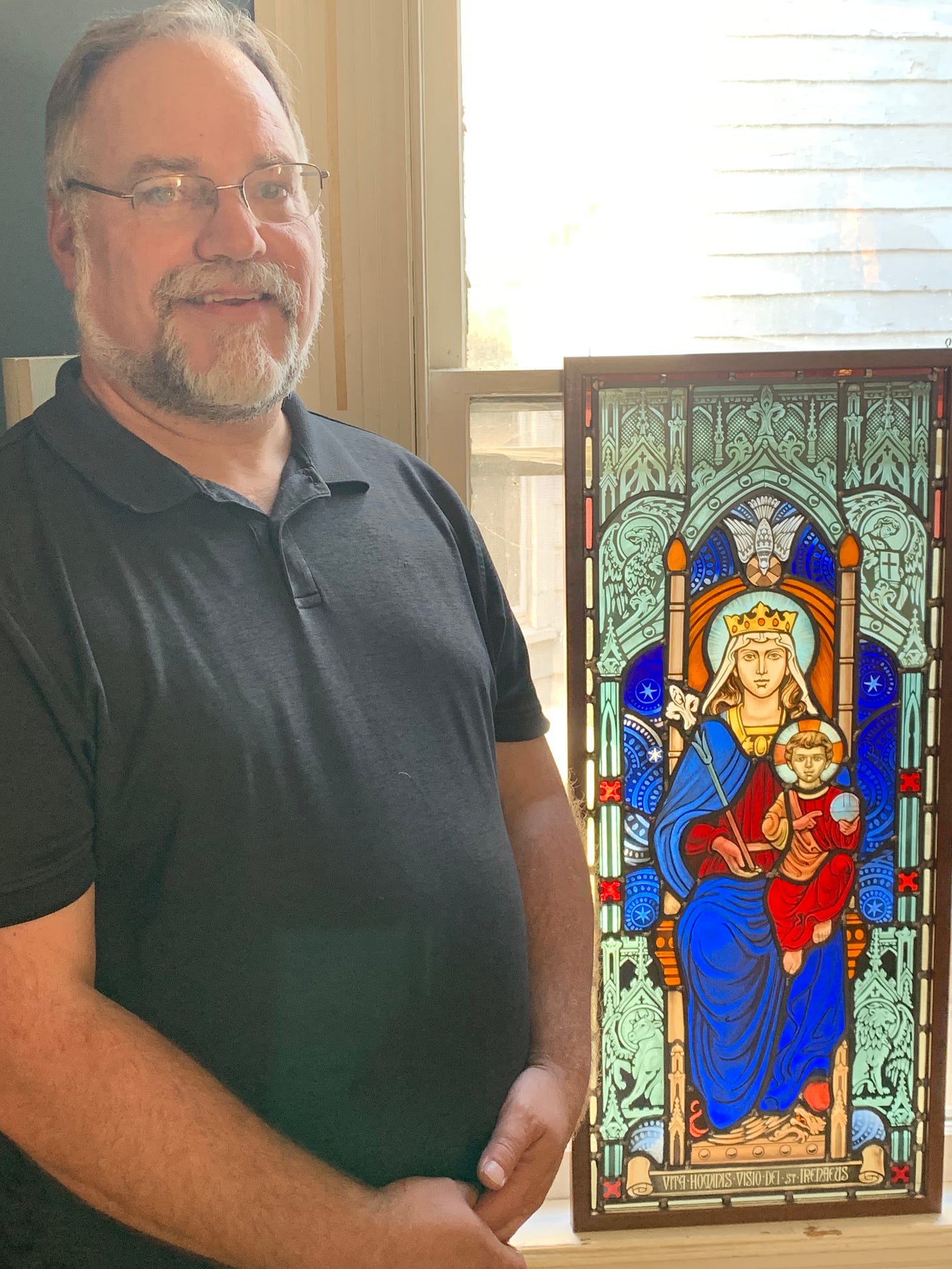Look at this amazing stained-glass window.
My friend Fr. Mark Bleakley—worldclass artist and Lead Designer for Willet Stained Glass Studios—personally designed and made it for me. He explains to me that he used Polish and German mouthblown glass. He painted, etched, and then kiln-fired the depictions, glazed each of the pieces, soldered lead strips between them, and framed the whole thing in woodstock. The process is unbelievable.
Mark gave my wife Linda and me a tour of the Willet Studios some years ago. Both the high artistic quality of the windows that he showed us and the intricacy of the technical process of making them are truly astounding. Look up his work on Facebook (Bleakley Stained Glass) or Instagram (@mystic.lamb.studio).
Believe it or not, Mark gave this window to me as a gift. I hardly need to add that the gift was entirely undeserved, which makes me all the more grateful for it.
On the picture, Mark poses with his handiwork in his home. I took the picture when Linda and I visited him and his wife Michelle in Winona, MN in October of last year.
Mark explained that the window is inspired by the statue of Our Lady of Walsingham, which is currently housed in the Catholic Basilica of Our Lady of Walsingham, also known as the Slipper Chapel, in Norfolk, England.
The window depicts the Virgin as sedes sapientiae (“seat of Wisdom”), with the Word or Wisdom himself holding the cosmic orb—the T-O orb representing the continents of Asia, Africa, and Europe. Seated on her heavenly throne, our Lady holds the Lily Rod, representing purity and sovereignty. She herself is Jesse’s rod (Isa. 11:1), which issues in the blossoming white fleur-de-lis (“lily flower”) of our Lord, upon whom, as the prophet says, rests the seven-fold Spirit of wisdom and understanding (Isa. 11:2). In line with a Christological reading of the Song of Songs, we are meant to see Christ in this flower—“the lily of the valleys” (Song 2:1).
The amber back of Mary’s throne reminds us that the seat is made of wood, while the amber backdrop also reveals the glow of the Spirit’s overshadowing. The throne serves also as an altar, covered by a baldacchino that is supported by two pillars with a total of seven rings (though the bottom one on the viewer’s right is not visible in Mark’s version), representing the sevenfold spirit of Isaiah 11 and alluding, at the same time, to the seven sacraments. Mark included amber flames for the tip of the two pillars, suggestive of divine wisdom.
Traditional iconography treats Mary as the Ark of the Covenant: Just as the Ark contained the Ten Commandments, so the Mother of God holds the eternal Wisdom of God—she is sedes sapientiae. Her altar/throne, therefore, is surrounded by the Cherubim of the Ark of the Covenant—the four living creatures (Ezek. 1:4–28; Rev. 4:6–8) of eagle, man, ox, and lion, traditionally associated with the four Gospels. Atop the baldacchino, the Spirit himself descends as the giver of all salvific gifts.
This depiction of salvation through the Virgin Mary has a broader, cosmic framework: The arch of Mary’s seat represents the rainbow—a sacrament of God’s faithfulness to all creation. The starry heavens surround the seat of wisdom, while the pillars of the earth on both sides of the window give stability to the cosmos and also shape the framework of the eternal kingdom of God.
Mary decisively tramples the Dragon underfoot, in fulfilment of the protevangelium of Genesis 3:15, “She shall crush thy head, and thou shalt lie in wait for her heel” (in the Douay-Rheims version). When the enemy is caught by a ray of sunlight, you can see its bright-yellow eye darting its furious look at you and its fiery tongue ready to inject you with its poison. But the Dragon’s defeat is unmistakable. His head is crushed, thanks be to God!
At my request, Mark placed one of the most famous sayings of the second-century bishop Saint Irenaeus in the banner at the lower end of the window: Vita hominis visio Dei (“The life of man is the vision of God”). This saying has been important to me for many years, and I am so grateful that I now get to read it every day.
I was rather nervous about driving this window all the way from Nashotah House Theological Seminary in Wisconsin (where I teach) to Langley, British Columbia (where we live). But we managed, and thankfully the window arrived in one piece. As you can see here, it now hangs prominently in one of our backyard windows.
I walk past it numerous times each day, reminded every time of God’s victory over the Serpent, of God’s astounding work of redemption, and of his faithful servant Fr. Mark Bleakley.




Thank you so much for sharing! What a kingly gift!
Incredible work here by Fr. Mark.